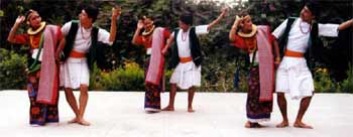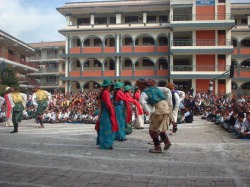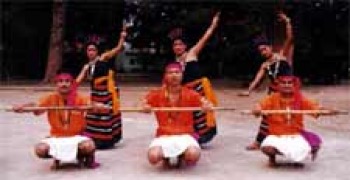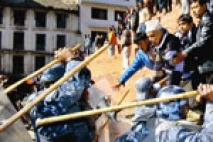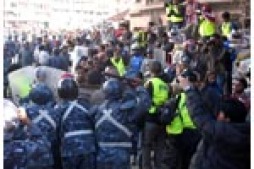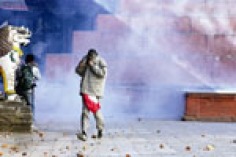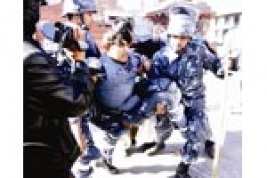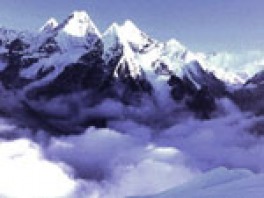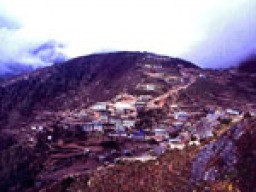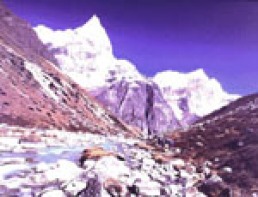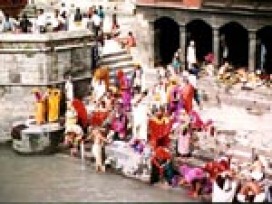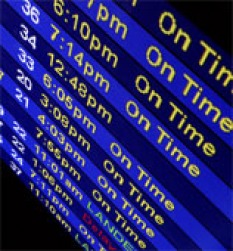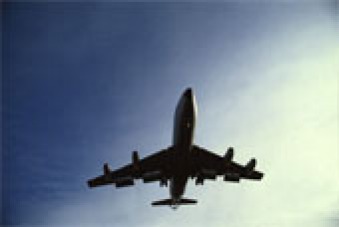True Nepal
ETHNICITY
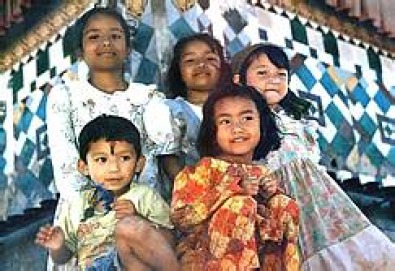
The early settlement of Nepal was accomplished by large-scale emigrations of Mongoloid groups from Tibet and of Indo-Aryan peoples from northern India. Nepalese of Indo-Aryan ancestry constitutes the great majority of the total population. Tibeto-Nepalese peoples form a significant minority of the country's population. Nepali, a derivative of Sanskrit, is the official language; Newari, a language of the Tibeto-Burman family, and numerous other languages are spoken. About 90% of the population is Hindu, and the remaining Buddhist.
The population is located mainly in rural areas. The urban population is primarily concentrated in Kathmandu. Nepalese people are divided into two distinct groups: the Indo-Aryans and the Mongoloids. Kathmandu Valley is the spiritual and cultural meeting point of all these groups. Nepal is the only Hindu Kingdom in the world. It is also the birthplace of Lord Buddha.
MUSIC & DANCE
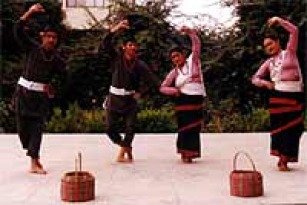
Music and dance are favorite pastimes in Nepal. Drums and wind instruments required in religious ceremonies have been preserved from ancient times. Devotional songs with folk and classical elements are an important feature of most religious and family occasions. Muttered chants, esoteric tantrik hymns and Nepalese music, whether it is the twang of a four-stringed saringhi or the plaintive notes of a flute, are very popular. Traditional folk musicians or gaines gather for an evening of singing and socializing, classical dancing and trance-like masked dances enliven the Kathmandu Valley and Bhaktapur regions, while no wedding would be complete without the raucous damais-Nepal's modern ensembles.
FAIRS & FESTIVALS
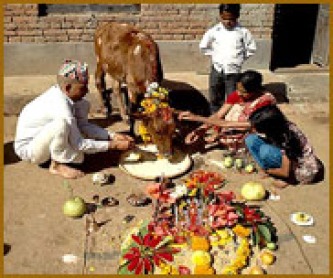
Nepal's festive calendar is frenzied and exciting. Dasain, celebrated nationwide in October, is the most important of all Nepalese celebrations and features the biggest animal sacrifice of the year. It is the same festival of Durga Puja in India. Tihar is celebrated in the month of November, where animals are honored. Other festivals celebrated nationally include the colorful Holi in March, Chaitra Daisan (or Basanti Puja) in April, Haribodhini Ekadashi in November, Maha Shivratri in March, Gai Jatra in August, and Krishna Jayanti in August/September. Buddhist celebrations include Mani Rimdu in November (in Solu Khumbu), Buddha Jayanti in May (in Kathmandu), and Losar or the Tibetan New Year in February (in Swayambhunath, Jawlakhel and highland communities). Other important festivals are New Year's Day (April 14), Mother's Day (April), Rath Jatra (May-June), Guru Poornima (August), Krishnashtami (August-September), Father's Day (August-September), Indra Jatra (September), Constitution Day (November 9), Bala Chaturdarshi (November-December), Birthday of His Majesty the King (December 28), Basanta Panchami (January-February), National Democracy Day (February 18), and Ghode Jatra (March-April).
ATTIRE
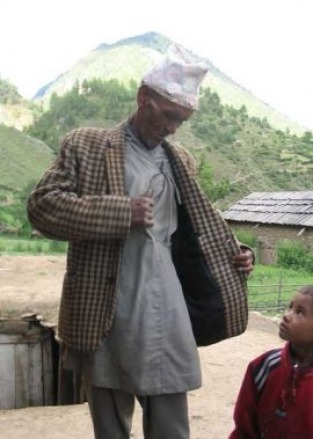
Nepalese men wear daura, suruwai, topi patuka (waist coat) and a khukri, while the women wear chowbandi choli, gunew tied by patuka, hembari (shawl tied round the chest) majetro. The ornaments include chyapte sun, gadavari (ear rings), tilhari kantha, chura, dungri, mundri (nose ring), kallis (ankle ornaments), sirbandi charrani har and tikmala. The sindur (vermilion) and the potey (bottle green) are the signs of married women.
CUISINE
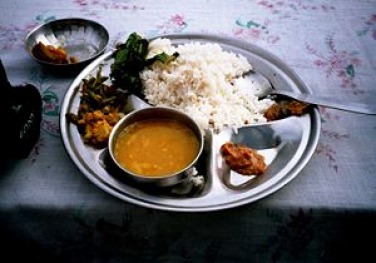
Most of the regular meals consist of a combination of lentil soup, rice and curried vegetables. Nepal has adapted to Western tastes, markedly evident in Kathmandu's smorgasbord of menus: Mexican tacos; Japanese sukiyaki; Thai chocolate; Chinese marshmallows; onion and minestrone soup; borscht, quiche and soy burgers; and some of the best desserts-apple and lemon pies, almond layer cakes, fruit cakes. Lassi (a refreshing mixture of curd and water), the locally produced beer or chang, a Himalayan home brew made from barley, are the most famous draughts.
POLITY
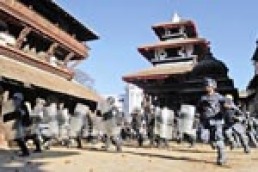
Nepal is a democratic constitutional monarchy. The constitution provides for a bicameral government consisting of a House of Representatives or the lower house with 205 elected members and a 60-member National Council or the upper house, a third of whose members retire every two years. The king is generally the titular head. A two-thirds majority in the lower house can only amend the constitution.
ECONOMY
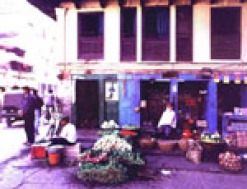
Nepal has an agrarian market economy. Agriculture accounts for about one-half of the GNP and employs more than nine-tenths of the workforce. Less than one-fifth of the total land area is arable, and agricultural productivity is very low. A hydroelectric station southeast of Kathmandu has proved to be very beneficial for the farmers.
Rice is the staple food. Maize, wheat, potatoes, sugarcane, and millets are also widely grown. Nepal is a major producer of medicinal herbs, which grow on the Himalayan slopes. Cattle, buffalo, goats, and sheep are raised. Forestry is an important industry.
The growing industrial sector accounts for much less than one-tenth of the GNP and employs less than 1 percent of the total workforce. The government has promoted the use of domestic raw materials in manufacturing, and leading manufactures include cotton garments, bricks, tiles, paper, construction materials, and processed foods. Traditional products such as baskets, edible oils, and cotton cloth are produced by cottage industries.
Tourism is becoming an increasingly important source of foreign exchange. The Kathmandu valley is equipped with the necessary amenities for foreign tourists.
India dominates Nepal's foreign trade and has granted only limited transit rights. Nepal's major exports include cotton garments, cereals, jute, timber, oilseeds, ghee, potatoes, medicinal herbs, and hides. Capital and consumer goods, mineral fuels, and chemicals dominate imports.
SITES TO VISIT
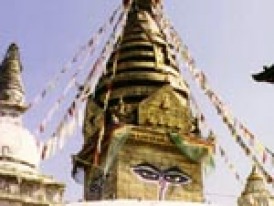
Nepal has three main cities of tourist attraction-Kathmandu, Patan and Bhaktapur. The capital city of Kathmandu offers many attractions to the visitor. It is the seat of the world famous Pashupatinath Temple. Kathmandu's core is Durbar Square, with the Vishnumati River to the west and Ratna Park to the east. The Baghmati River forms the southern boundary, while Thamel, the budget travelers' hangout, sprawls to the north.
Patan has many pleasant attractions like the Durbar Square, Royal Palace, Jagannarayan Temple, Golden Temple, Kumbeshawar, a collection of Buddhist stupas, Nepal's only zoo, and the Tibetan carpet market at Jawlakhel.
Bhaktapur, 35 km from Kathmandu, offers attractions like the Durbar Square, famous for its temples, squares, statues and columns, Taumadhi Tole Square, Nyatapola Temple, Til Mahadev Narayan, Potters' Square, and Tachupal Tole Square.
In the Terai region, the Royal Chitwan National Park and Janakpur, the legendary birthplace of Goddess Sita of the Ramayana, are the oft-visited sites. Pokhara is famous for its picturesque setting, Tibetan settlements, hilltop monasteries, the Devi Falls, caves and lakes. The Dakshina Kali Temple, south of the Kathmandu Valley, attracts hundreds of pilgrims everyday. The Nagarjuna forest reserve is also a treat for the nature lover.
ADVENTURE SPORTS
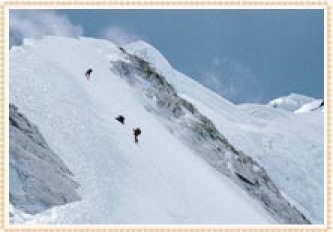
Nepal provides a large range of adventure sports. Trekking is possible in the months of September and December and March and April. The Everest region boasts of the highest mountains of the world such as Mt. Everest, Lotse, Nuptse, and Ama Dablam and is the home of the Sherpas, Lamas and Buddhist culture. In the Annapurna region, most of the treks commence from the Pokhara Valley, and one has to cross the Throng La at 5416 m here. Towards the north of Kathmandu, the Central region covers the treks in the Kathmandu Valley, Langtang, and Gosaikunda. In the far western region, the Phoksindo National Park covering an area of 3555 sq km is an oft-visited site. It boasts of the Rara Lake, Upper and Lower Dolpo, Mt. Kailash and Simikot. In the far eastern region, one can find the spectacular peaks of Kanchenjunga, Makalu and Junu.
For those who cannot withstand the rigorousness of mountain climbing, there are mountain flights from Kathmandu that fly around the Mount Everest and provide a close look of the top of the world. From Nagarkot (32 km east of Kathmandu) and Daman (80 km southwest of Kathmandu) one can have a distant view of Mount Everest and beautiful Himalayan ranges. Trekking is the best way to get to interesting and remote mountain villages of Nepal and to have a glimpse of their lifestyle untouched by modern civilization.
Rafting and kayaking are immensely popular, especially on the Trisuli River near Kathmandu and the Sun Kosi in Dolalghat. Remoter challenges include the Karnali (a two-day trek from Surkhet) and the Tamur (a three-day trek from Dobhan in eastern Nepal). Other activities include mountain biking in the Kathmandu Valley and safari in the Terai.
PARAGLIDING
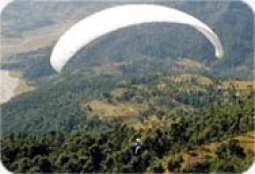
Paragliding in Nepal can be truly wonderful and fulfilling experience for the adventure seeking. A trip will take you over some of the best scenery on earth, as you share airspace with Himalayan griffin vultures, eagles, kites and float over villages, monasteries, temples, lakes and jungle, with a fantastic view of the majestic Himalaya . Gliding is a weather dependent sport and the flying season in Nepal through February, the best months being November and December. The take-off point for these flights is Sarangkot (1592 m.), which also offers prime views of Phewa Lake and the mountains at sunrise and sunset (provided the skies are clear) and the landing is by the lake. No previous experience is required as qualified pilots provide a short briefing before launching.
Bird Watching in Nepal
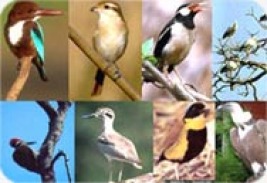
Nepal is a paradise for bird lovers with over 848 species (almost 8% of the world total) of birds. And among them almost 500 hundred species are found in the Kathmandu Valley alone. The most popular bird watching spots in Kathmandu are Phulchoki, Godavari , Nagarjun, Bagmati river, Taudaha and so on. Get your binoculars and look forward to a rewarding experience.
Nepal Mountain Flights
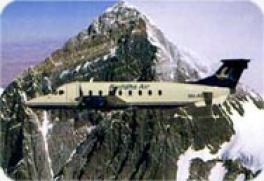
White water rafting is a special venture in the river on an inflatable rubber boat. A river trips in usually an adventure but not always. The most thrilling, exciting and exotic river trips in Nepal can be arranged with a registered rafting agency only. You have to choose river trips lasting 1 to 12 days on some of the best and exciting rivers in Nepal. These wild rivers rising from the hidden plateau of Tibet cu deep down the rugged sloppy mid-hills of Nepal and then finally meander across the Indian Plain to join the holy waters of the River Gangs.
Bungy Jumping
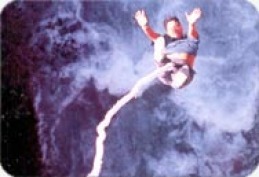
The ultimate thrill of a bungy jump can now be experienced in Nepal at one of the best sites that this sport can boast of anywhere in the world. Nepal's first bungy jumping site is situated 160 m. over the Bhote Kosi river, inviting you to experience the ultimate adrenaline rush in the surroundings of this amazing place. The jump, at 160 m., is staffed and operated by some of the most experienced jumpmasters in the business.
Ultra Light Aircraft
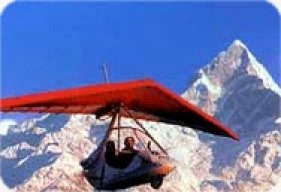
Ultra-light aircraft take off from Pokhara and offer spectacular views of the lakes, mountains and villages. This is an ideal way to see life from a new perspective. The choice of the Pokhara Valley for ultra-light aircraft is appropriate chiefly because of the proximity of the mountains, and the scenic lakes. For those who wished they could fly like birds when growing up, this flight is a must. It might be lonely at the top, but the spectacular view from up high certainly makes it all worth it. Flights are from the Pokhara airport beginning September through June. The flights take place from sunrise to 11 a.m. and from 3 p.m. to sunset everyday during these months.
Nepal River Rafting in Nepal
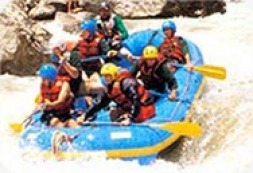
White water rafting is a special venture in the river on an inflatable rubber boat. A river trips in usually an adventure but not always. The most thrilling, exciting and exotic river trips in Nepal can be arranged with a registered rafting agency only. You have to choose river trips lasting 1 to 12 days on some of the best and exciting rivers in Nepal. These wild rivers rising from the hidden plateau of Tibet cu deep down the rugged sloppy mid-hills of Nepal and then finally meander across the Indian Plain to join the holy waters of the River Gangs.
HOW TO REACH
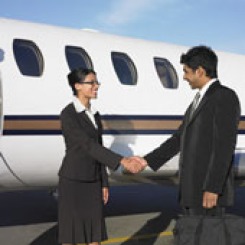
Royal Nepal Airlines, the national flag carrier of Nepal, and other International airlines operate scheduled flights to Kathmandu from Bangkok, Bombay, Calcutta, Delhi, Dubai, Varanasi, and several other cities. The international airlines operating their flights to Kathmandu include Aeroflot, Biman Bangladesh Airlines, China South West Airlines, Druk Air, Indian Airlines, Lufthansa, Pakistan International Airlines, Singapore Airlines and Thai International.
Public buses are the main form of transportation and are cheap, although uncomfortable and tedious. Buses ply almost on every road-paved or unpaved. There are several services between Kathmandu and Pokhara aimed specifically at tourists. There are no trains and no drive-yourself rental cars in Nepal. Cars with drivers can be hired.
Bike riding is gaining popularity with visitors for short jaunts and a bike is often quicker than using local buses, especially in the Kathmandu Valley. Walking is still the most important and most reliable method of getting to places and for moving cargo. In several parts of Nepal walking is the only option. Human porters carry more goods than by every other form of transport combined.
Local transport in the Kathmandu Valley and around Pokhara includes taxis, buses, tempos (three-wheeled buses), auto-rickshaws, rickshaws and bicycles.
OTHER INFORMATION
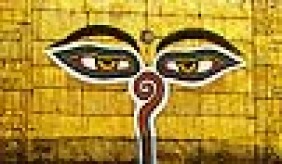
The Department of Immigration located at Tridevi Marg, Thamel (Ph: 412337) issues trekking permit for the tourists who intend to trek any part of the country. Trekking permit fee for different trekking areas are fixed.
Trekking to Dolpa, Kanchenjunga, Makalu and Mustang can be undertaken through registered trekking agencies only. To trek in a national park area an entrance fee has to be paid separately. Likewise, an entrance fee is also collected from every trekker going into the Annapurna Conservation Area. There are several government registered trekking agencies in Nepal to conduct such trekking programs.
All foreign nationals (except Indians) require visas. Single-entry tourist visas are issued for up to 30 days and can be extended for a maximum of three months. They permit travel around the Kathmandu Valley, Pokhara and Chitwan National Park in the Terai. Trekking permits are required if one intends striking out from the main roads. They can be obtained from immigration offices in Kathmandu and Pokhara.
Altitude sickness, hepatitis A, malaria (low-lying areas only), meningococcal meningitis (Kathmandu Valley region) and typhoid are the general health risks.
LOCATION
It borders with the Tibet Autonomous Region of the People's Republic of China in the North and India in the East, South and West respectively. AREA: 147,181 sq. kilometers.
ALTITUDE: Varies from 70 meters to 8848 meters.
CAPITAL: Kathmandu.
POPULATION: 1,84,91,097
LANGUAGE:
Nepali is the national language of Nepal. Educated people understand and speak English as well.
TIME:
Nepal Time is 5 hours 45 minutes ahead of GMT and 15 minutes ahead of Indian standard time.
CLIMATE
Nepal has four major seasons, namely, (1) Winter: December-February, (2) Spring: March-May, (3) Summer: June-August, (4) Autumn: September- November.
Nepal can be visited the whole year round.
PEOPLE & RELIGION
Nepalese people are mainly divided into two distinct groups the Indo-Aryans and the Mangoloids. Kathmandu Valley is the spiritual and cultural meeting point of all these groups. Nepal is the only Hindu Kingdom in the world. Hindu Temples and Buddhist shrines are scattered all over the kingdom. Nepal is the birthplace of Lord Buddha, the Light of Asia. There is a complex blending of Hinduism and Buddhism in Nepal. WHAT TO WEAR
Except in formal gathering informal clothes are acceptable mostly everywhere. Warm garments are required in October-March. An umbrella or a rain coat are must for the rainy season.
CURRENCY & FOREIGN EXCHANGE
Nepali Rupee notes come in Rs. 1, Rs. 2, Rs. 5, Rs. 10, Rs. 20, Rs. 50, Rs. 100, Rs. 500 and Rs. 1000 denominations. Coins come in 5p, 1 0p, 25p, Rs. 1 & Rs. 5 denominations.
Foreign currencies must be exchanged only through the banks or authorized foreign exchange dealers. The receipts from such transactions are to be obtained and retained. Visitors can exchange foreign currency at the foreign exchange counter at the airport upon arrival. Visitor other than the Indian nationals have to make the payment in hotels, travel or trekking agencies and air tickets in foreign currency. Non-lndian visitors are not allowed to import or export Indian Currency. The approximate value of one US Dollar is equivalent to Rs. 50.97 as of June 1995.
ENTRY PROCEDURES
All visitors except the Indian nationals must hold a passport and a valid visa. The visas can be obtained at the Nepalese Diplomatic Missions and Consuls abroad and entry points issue visa for a 15 days. The visa will be extended at the Department of Immigration, Tridevi Marg, Thamel, Tel: 412337/418573. The Department also issues multi entry visa for the visitors.
ENTRY POINTS:
By Air: Tribhuvan Internaitonal Airport, Kathmandu.
By Land: (1) Kakarbhitta (2) Birgunj (3) Belhiya (Bhairahawa) (4) Nepalgunj (5) Dhangadi (6) Jogbani (Biratnagar) and (7) Mahendra Nagar in Nepal-lndia border and Kodari in Nepal-China border. The overland tourists entering the Kingdom with their vehicles must possess an international carnet.
CUSTOMS
All baggage is subject to customs' check at the point of entry. Visitors are allowed to bring in the consumable articles such as liquor one bottle up 1.15 litres, 200 sticks of cigarette, 15 rolls of photo film and 12 rolls of movie camera film. Visitors are also allowed to carry one binocular, one camera, one movie camera, one video camera, one radio, one tape recorder, one bicycle, one wrist watch, one set of fountain pen, one perambulator, 15 radio cassettes & 10 disk records into the country on the condition that they are declared and are to be taken back on return. Carrying narcotics, arms and ammunitions are strictly prohibited. Visitors can export souvenirs to their respective countries. The export of antiuques requires special certificate from the Department of Archaeology, National Archive Building, Ram Shah Path, Kathmandu (Tel: 215358), Gold, silver, precious stones, wild animals and their skins, horns, etc, all drugs whether processed or in their natural state, are prohibited to export.
Top
TRAVEL ROUTE
Royal Nepal Airlines the national flag carrier of Nepal and other International airlines operate scheduled flights to Kathmandu from Bangkok, Bombay, Calcutta, Delhi, Dubai, Dhaka, Paro, Varanasi, Frankfurt, Paris, Hongkong, Karachi, London, Moscow, Singapore and Lhasa.The International Airlines operating their flights to Kathmandu include Aeroflot, Biman Bangladesh Airlines, China South West Airlines, Druk Air, Indian Airlines, Lufthansa, Pakistan International Airlines, Singapore Airlines and Thai International. AIRPORT TAX
Rs. 600 per person for departure to SAARC (South Asian) Countries and Rs. 700 for departure to other international destinations. For domestic flights those flying within Nepal are required to pay Rs. 50.
INTERNAL TRANSPORT
Royal Nepal Arilines has an extensive network of air services in the interior of Nepal. This include Taplejung, Bhadrapur, Rajbiraj, Bhojpur, Phapl, Lukla, Lamidanda Tumlingtar, Rumjatar, and Biratnagar in the East; Nepalgunj, Chaurjhari, Surkhet, Dang, Rolpa and Jumla, in the Mid-West, and kolti, Mahendranagar, Dhangadi, Silgadi (Doti), Tikapur, Sanphebagar, Baitadi, and Darchula in the Far Western Region. Besides Royal Nepal Airlines, the other domestic airlines such as Nepal Airways, Everest Air, Asian Airlines Helicopter, Necon Air provide regular and charter services to different popular domestic destinations.
MOUNTAIN FLIGHT
Royal Nepal Airlines and other domestic Airlines in the private sector also operate breathtaking mountain flights for the tourists round the year.
AIRPORT TRANSPORTATION
In addition to metered taxis, limousine service is also available at the airport for transport to major hotels in the city.
Top
OTHER TRANSPORT ARRANGEMENTS
Metered taxis having black plates with white figures are available in Kathmandu. Metered tempos (three wheeler scooter) are also available and are slightly cheaper than taxis. Bicycles, motorcycles and rickshaws are also available on hire. The fare for the bicycles or motorcycles is fixed wheareas the fare of rickshaws is to be negotiated. There are regular bus services between the main town of the Kathmandu Valley. The Bus Terminal is located at Gongabu (new bus terminal) and Bagbazar (old bus terminal). Similarly, scheduled bus services for outside the Valley operate from the Gongabu Bus Terminal which is located at Balaju, Kathmandu. TREKKING PERMIT
The Department of Immigration located at Tridevi Marg, Thamel (Tel 412337) issues trekking permit for the tourists who intend to trek any part of the country. Trekking permit fee for different trekking areas are fixed as follows.
Trekking areas Trekking permit fee 1. Annapurna, Everest,Langtang and Rara Equivalent to US$ 5 per person per week for the first four weeks and US$ 10 per week thereafter. 2. Dolpa and Kanchenjunga Equivalent to US$ 10 per person per week for the first four weeks and US$ 20 per week thereafter. 3. Manaslu US$ 75 per person per week. 4. Mustang and upper Dolpa US$ 700 per person for the first ten days and US$ 70 per person per day thereafter.
Note: Trekking to Dolpa, Kanchenjunga, Makalu and Mustang can be undertaken through registered trekking agencies only. To Trek in a national park area an entrance fee of Rs. 650.00 is to be paid separately. Likewise, an entrance fee of Rs. 200.00 is also collected from every trekker going into the Annapurna Conservation Area. There are several government registered trekking agencies in Nepal to conduct such trekking programmes.
FACILITIES
Nepal has every type of accommodation facilities that a tourist might ask for. This ranges from the international standard star hotels to budget hotels and lodges. Similarly one can also have a choice of sightseeing from a range of different tour packages. In order to have an assured quality service it is advisable to use the facilities and services of government registered hotels, lodges, travel agencies the licensed tour guides only and engage an authorized guide or porter only through a registered travel/trekking agency.
Top
MAJOR TOURIST ATTRACTIONS
Very few countries in the world can offer as many varieties of adventure tourism packages as Nepal. Of the 14 peaks above 8000 meters in the world eight are located in Nepal. It is the land of Sagarmatha (Mount. Everest, 8848 meters), the highest peak in the world and other 1310 mountain peaks. For those who can not withstand the rigorousness of mountain climbing there are mountain flights which fly around the Mount Everest and provide a close look of the top of the world. Also from Nagarkot (32 kilometers East of Kathmandu) and Daman (80 Kilometers south-west of Kathmandu) one can have a distant view of Mount Everest and beautiful Himalayan ranges. Trekking is the best way to get to interesting and remote mountain villages of Nepal and to enjoy views of the famous peaks together with their lifestyle untouched with modern civilization.
The river rafting,which is known as "White Water Adventure" represents another major attractions. Within distance of 100 miles, one can see the topographical variations with the rivers rising from the higher points near Nepal's Tibetan border and then dropping dramatically to lower levels the plains bordering India. For those who wish to view wildlife, Nepal offers plenty of scope. Of the eight National Parks and four Wildlife Reserves and two conservation areas in Nepal.
For the less adventures, Pokhara, the lake city of Nepal has no equal as it provides ample opportunities for fishing, swimming, canoeing and boating along with the sightseeing of majestic panoramic views in its background. It is only Pokhara, a tropical spot with an altitude of about 900 meters where from one can see the mountain crossing over 8000meters from such a short distance of about 40 kilometers. For the nature lovers Nepal is such a land of natural beauty that metaphors cannot delineate its real picture. At the sametime, Nepal proffers an incomparable scope to the scholars and connoiseurs of art and culture to see and study the different aspects of the fine-arts be it painting, sculpture, wood carving or architecture.
Kathmandu Valley possesses several historical monuments, old palaces and palace squares, shrines and temples, ageless traditions and legends all make it a living museum that any visitor would cherish its vivid memory in his/her heart for ever. Nepal is the land of Lord Pashupatinath, which is supposed to be the holiest Hindu temple in the world. Besides, two out of the four main holy places (chhetras) of Hindu pilgrimages namely Muktichhetra and Varahachhetra,are located in Nepal. Not only for the Hindus but also for the Buddhists Nepal offers a unique place of pilgrimage as it happens to be the birthplace of Lord Buddha, the apostle of peace and compassion.
Nepal is a land of Festivals with some part of the Kingdom or the other celebrating some festival during everyday of the year. Festivals may be linked with the remembrance of the departed soul, to herald the different seasons, to mark the beginning or end of the agricultural cycle, to mark the national events, or just family celebrations. On a festive day the Nepalese take their ritual bath, worship different gods and goddesses, visit temple, observe fasting and undertake feasting. The most important aspect of Nepali culture is the religious harmony and understanding prevailing among the Hindus and Buddhist. Some of the major festivals of Nepal are:
New Year's Day-April 14,(First day of Baisakh)
Matatirtha Aunsi or Mother's Day - (April)
Buddha Jayanti - (April)
Machchendranath Rath Jatra- (May-June)
Guru Poornima (August)
Gaijatra (August)
Krishnashtami - (August-September)
Gokarna Aunsi or Father's Day - (August-September)
Indra Jatra - (September)
Bada Dashain - (September-October)
Tihar- (October-November)
Constitution Day - (November 9, ie. Kartik 23)
Bala Chaturdarshi - (November-December)
Birthday of His Majesty the King - (December 28, ie. Paush 14)
Birth-Anniversay of His Late Majesty King Prithvi Narayani Shah, The Great - (January 10, ie. Paush 27)
Basanta Panchami - (January-February)
National Democracy Day- (February 18, ie. Falgun 7)
Maha Shivaratri - (March-April)
Ghode Jatra - (March-April)
If someone really wants to be away for sometime from the cacophony of modernization, here is Nepal,the best sojourn cradled in the lap of the Himalayas that never cases to offer eternal peace and tranquility.
